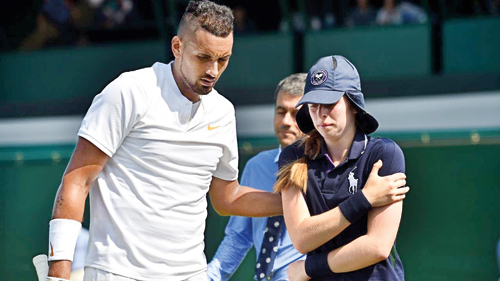Story Telling Wimbledon-draw

Australia's Nick Kyrgios consoles a ball girl after she was hit by a serve
The sight of Wimbledon Centre Court on the opening Monday, is one of the most appealing sights in the world of sports. It looks more of a painter’s canvas than a playing field. It is about the best promotional poster for Tennis. For top ranked players it can be a haven or Green-Waterloo.
If there is a draw-sheet which could reveal who’s who and how continents and countries are placed and fairing in the world of Tennis, it has to be the Wimbledon championships.
About 210 countries play Tennis in one form or other. ITF, the biggest known Tennis body, has 207 countries as members. We are one of them. However, the player-base for Tennis are the two professional bodies. They are WTA and ATP for Men. While this is the backdrop of Tennis, in events, the showpiece of Tennis and the jewel in the Grand Slam crown is the Wimbledon Championships in London.
In Wimbledon Singles, each gender has 128 in the main draw. Counting all events in Wimbledon 2018, there will 500 plus players from 59 countries. Europe will have 177 players, along with USA 54 and Australia 24. Half the good players in the world come from just 9 countries. This gives a good idea as to where Tennis is thriving and where its struggling. The unspoken part of the Wimbledon draws reveal more than what casual eyes could see.
Wimbledon Tennis
By Day 3 of the event last Tuesday, Caroline Wozniacki, Maria Sharapova, Sloane Stephens, Alice Cornet, Caroline Garcia and Elina Svitolina were out of the Women’s draw. Katie Swan of England and Vitalia Diatchenko of Russia in their maiden appearances at Wimbledon, with appealing Tennis, sent Maria Sharapova out of the draw.
In the Men’s draw too, an equal number of rankings went out. Grass is not the easiest surface to settle down on, even for the best of players. Unseeded Stanislas Wawrinka, still struggling with injuries, sent home 7th Seeded Grigor Dimitrov of Bulgaria .
While the Wimbledon committee has the power to include into or exclude players from the draw, the WTA and the ATP exert a good deal of influence in the manner the draw is made and the Seeding of players. Generally, player placement as Seeds is done with the interest of having good matches in the Final Rounds. This is of mutual interest to the tournament committee and the professional bodies. The professional bodies’ concern is to maintain fair play, good image of Tennis and beyond anything else, that the players go home with a fair amount of money in their pockets. On this front, Wimbledon is the venue where it all began way back over 100 years ago. The All England Club, the event owners, have relentlessly, over good times and bad, kept the spirit of the game.
Money
Wimbledon is one of the late comers to accept professional Tennis. Wilhelm Bungert, Runner-up to Australia’s John Newcombe in the 1967 Singles, showed me the cheque he got as Runner up, it was just 37 Pounds Sterling! In 1969, Wimbledon permitted professionals to play and the purse has grown since then. Now the total prize money is around 25 million Pounds Sterling. Even the First-round winner goes home with Pounds Sterling 63,000.
Today, Wimbledon Championships week is the time and venue to be, to see the best of Tennis and players. It is the only venue which has a players’ dress code and a written code as when to appear and leave the court. It is very English. In the casual and commercial world of sport, Wimbledon is about the only one which controls dress and commercial labelling on players.
Entering the draw
There are only 3 avenues for a name to appear in the Draw. First priority is the Professional ranking. Second would be coming through Qualifying Rounds. The third is ‘Wild-Card’ privilege of the organising committee. It stops here. WTA and ATP, if they notice underhand work, they could withdraw their membership from participating. I do not see this possibility in tradition-bound British Isles. The 12-month rotary validation of the world professional ranking comes out every Monday. If the player is within the cutoff mark, he/she gets direct entry.
 The ‘Wild-Card’ is given to promising players as encouragement. On Monday last week, 19-year-old British ‘Wild-Card’ entry Katie Swan, beat seasoned campaigner Romanian Begu. Katie Swan’s service did the damage throughout the match. While the other ‘Wild-Card’ entrant Harriet Dart did give a scare to world No.7 Katerina Pliskova, by winning the 1st Set.
The ‘Wild-Card’ is given to promising players as encouragement. On Monday last week, 19-year-old British ‘Wild-Card’ entry Katie Swan, beat seasoned campaigner Romanian Begu. Katie Swan’s service did the damage throughout the match. While the other ‘Wild-Card’ entrant Harriet Dart did give a scare to world No.7 Katerina Pliskova, by winning the 1st Set.
Tough early Rounds
Even in Round 1, the Women were serving at 100 mph, while the Men’s Services went at about 140 mph. It is of no use expecting an unarmed opponent in Wimbledon. Only the best players in the world are in the draw, and are armed to the teeth. Players will have to walk through tough challenges and new talents in the early Rounds, to appear in Round 3. For the good players, it is also important they come through the early Rounds without being too tired, otherwise, they will burn out in the final Rounds.
George Paldano, Former int. player; Accredited Coach of German Federation; National coach Sri Lanka & Brunei, Davis-Cup, Federation Cup captain/coach– contact 94 77 544 8880 geodano2015@gmail.com


